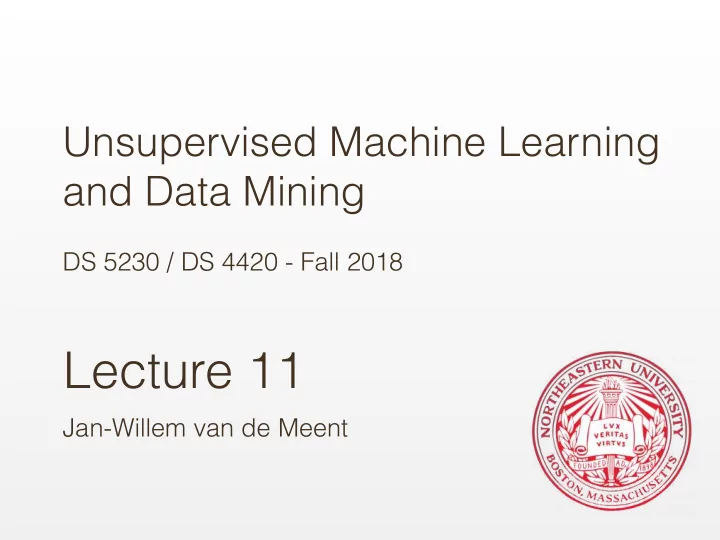

Unsupervised Machine Learning and Data Mining DS 5230 / DS 4420 - Fall 2018 Lecture 11 Jan-Willem van de Meent
Clustering
Clustering • Unsupervised learning (no labels for training) • Group data into similar classes that • Maximize inter-cluster similarity • Minimize intra-cluster similarity
Four Types of Clustering 1. Centroid-based (K-means, K-medoids) Notion of Clusters: Voronoi tesselation
Four Types of Clustering 2. Connectivity-based (Hierarchical) Notion of Clusters: Cut off dendrogram at some depth
Four Types of Clustering 3. Density-based (DBSCAN, OPTICS) Notion of Clusters: Connected regions of high density
Four Types of Clustering 4. Distribution-based (Mixture Models) Notion of Clusters: Distributions on features
Density-based Clustering
DBSCAN noise arbitrarily shaped clusters (one of the most-cited clustering methods)
DBSCAN noise arbitrarily shaped clusters Intuition • A cluster is a region of high density • Noise points lie in regions of low density
Defining “High Density” Naïve approach For each point in a cluster there are at least a minimum number (MinPts) of points in an Eps-neighborhood of that point. cluster
Defining “High Density” Eps-neighborhood of a point p N Eps (p) = { q ∈ D | dist (p, q) ≤ Eps } Eps p
Defining “High Density” ‒ ‒ ‒ • In each cluster there are two kinds of points: ̶ points inside the cluster (core points) ̶ points on the border (border points) ̶ ̶ cluster ̶ ̶ An Eps-neighborhood of a border point contains significantly less points than an Eps-neighborhood of a core point.
Defining “High Density” Better notion of cluster For every point p in a cluster C there is a point q ∈ C, so that (1) p is inside of the Eps-neighborhood of q bo and ∈ (2) N Eps (q) contains at least MinPts points. core ∈ border points are connected to core points p ∈ q core points = high density (q) | = 6 ≥ 5 =
Density Reachability Definition A point p is directly density-reachable from a point q with regard to the parameters Eps and MinPts, if p ∈ N Eps (q) 1) (reachability) 2) | N Eps (q) | ≥ MinPts (core point condition) Parameter: MinPts = 5 p p directly density reachable from q p ∈ N Eps (q) ∈ q | N Eps (q) | = 6 ≥ 5 = MinPts (core point condition) (q) | = 6 ≥ 5 = (q) | = 6 ≥ 5 = q not directly density reachable from p | N Eps (p) | = 4 < 5 = MinPts (core point condition) Note: This is an asymmetric relationship
Density Reachability Definition A point p is density-reachable from a point q with regard to the parameters Eps and MinPts if there is a chain of points p 1 , p 2 , . . . ,p s with p 1 = q and p s = p such that p i+1 is directly density-reachable from p i for all 1 < i < s-1. p MinPts = 5 p 1 | N Eps (q) | = 5 = MinPts (core point condition) q | N Eps (p 1 ) | = 6 ≥ 5 = MinPts (core point condition) ) | = 6 ≥ 5 =
Density Connectivity Definition (density-connected) A point p is density-connected to a point q with regard to the parameters Eps and MinPts if there is a point v such that both p and q are density-reachable from v . p MinPts = 5 v q Note: This is a symmetric relationship
Definition of a Cluster A cluster with regard to the parameters Eps and MinPts is a non-empty subset C of the database D with For all p, q ∈ D: ∈ 1) (Maximality) If p ∈ C and q is density-reachable from p ∈ with regard to the parameters Eps and MinPts, then q ∈ C. ∈ For all p, q ∈ C: ∈ (Connectivity) 2) The point p is density-connected to q with regard to the parameters Eps and MinPts.
Definition of Noise Let C 1 ,...,C k be the clusters of the database D with regard to the parameters Eps i and MinPts I (i=1,...,k). The set of points in the database D not belonging to any cluster C 1 ,...,C k is called noise: Noise = { p ∈ D | p ∉ C i for all i = 1,...,k} Noise n ly shaped clusters Cluster
DBSCAN Algorithm (1) Start with an arbitrary point p from the database and retrieve all points density-reachable from p with regard to Eps and MinPts. (2) If p is a core point, the procedure yields a cluster with regard to Eps and MinPts and all points in the cluster are classified. (3) If p is a border point, no points are density-reachable from p and DBSCAN visits the next unclassified point in the database.
DBSCAN Algorithm Original Points Point types: core, border and noise
DBSCAN Complexity • Time complexity: O(N 2 ) if done naively, O(N log N) when using a spatial index ( works in relatively low dimensions ) • Space complexity: O(N)
DBSCAN strengths Original Points Clusters + Resistant to noise + Can handle arbitrary shapes
DBSCAN Weaknesses Ground Truth MinPts = 4, Eps=9.92 MinPts = 4, Eps=9.75 - Varying densities - High dimensional data - Overlapping clusters � � � � � � � � �
Determining EPS and MINPTS Eps noise cluster 1 cluster 2 • Calculate distance of k -th nearest neighbor for each point • Plot in ascending / descending order • Set EPS to max distance before “jump”
K-means vs DBSCAN K-means DBSCAN
Recommend
More recommend